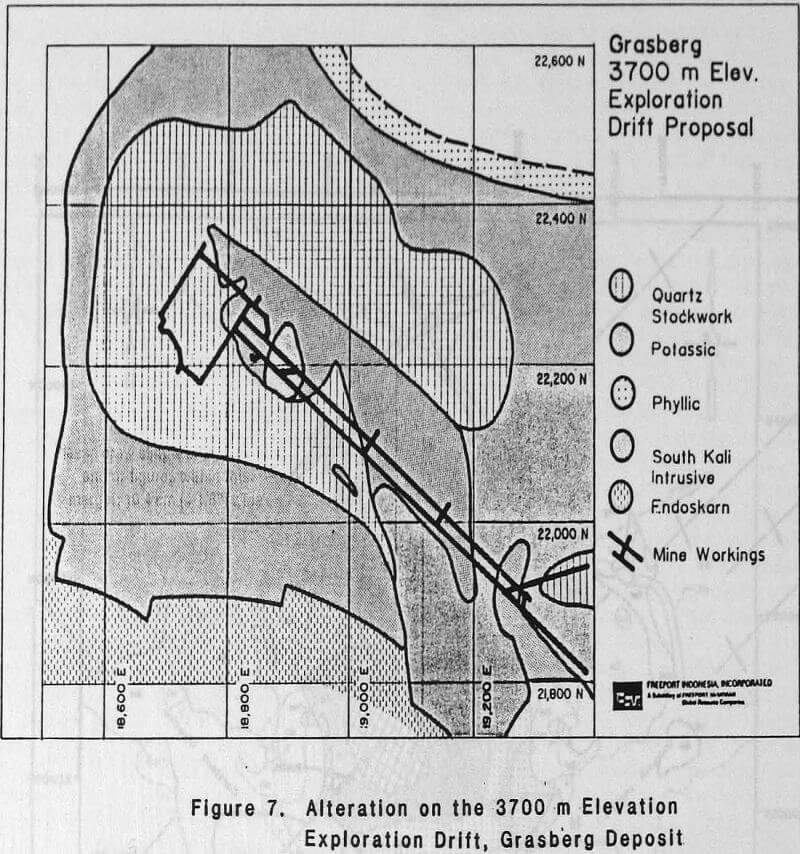Table of Contents
The Grasberg copper-gold orebody is contained with a young igneous complex of dioritic composition which intrudes limestones of the Tertiary New Guinea Group. Alteration is typical of porphyry copper deposits worldwide except that higher grade primary chalcopyrite with significant gold values is associated with a centrally located zone of strong quartz stockwork.


The Grasberg was generally regarded as a 0.7% porphyry copper target with little or no chance of having an enriched chalcocite blanket. The leached capping appears weak and the general area has been glaciated within recent times.

Regional Geology
The island of New Guinea has long been recognized as the product of collision between the north-moving Australian plate and the southwest-migrating Pacific plate. Convergence and deformation of the northern edge of the Australian plate probably began during Eocene time. The resulting geologic and physiographic features of New Guinea, and especially Irian Jaya, can be divided into three distinct geotectonic provinces: (1) southern coastal plains, (2) central mobile fold belt, and (3) northern Pacific plate margin.
Undeformed Continental crust of the Australian plate extends northward from beneath the Arafura Sea along the southern coastal plain to the southern edge of the central range. Rocks identified in oil exploration holes range from Paleozoic sediments to late Paleozoic/mid-Tertiary shelf sediments to unconsolidated Plio-Pleistocene clastic sediments.
Grasberg
The Grasberg copper-gold porphyry mineralization is totally within the Grasberg intrusive complex which forms a circular stock roughly 3 sq km in size. The complex intrudes limestones of the Tertiary Ainod and Faumai formation of the New Guinea Group.
The most economically important intrusive within the complex is the Grasberg diorite which is a fine-medium grained, porphyritic diorite composed of phenocrysts of plagioclase (55%), hornblende/augite (10%), and brown biotite (3%), with local quartz grains in a groundmass (35%) of fine-grained biotite and feldspar. Magnetite in amounts of 2-5% is a distinguishing accessory mineral. Sulfides, mainly as disseminated pyrite, constitute 2-4% of the rock.
Alteration assemblage at the Grasberg copper-gold porphyry deposit is fairly typical of other porphyry copper deposits throughout the Pacific Rim and especially of those in the southwest Pacific Basin.
A central potassic core with quartz stockwork grades outward into phyllic and then into a thin propylitic zone near the intrusive contact with the limestones. Brecciation and marble characterize the limestones within several hundred meters of the contact.
Stockwork alteration is the most important economically and is developed in potassically altered rocks near the center of the Grasberg intrusive complex.
Mineralization
Hypogene sulfide mineralogy is fairly standard and includes pyrite, chalcopyrite, bornite, digenite, and covellite dominating. Digenite and covellite are almost always found as rims around chalcopyrite and are volumetrically of minor importance. These rims are found at great depths within the deposit and as such appear unrelated to supergene effects. This appears to be a high sulfide system, +5%.
Chalcopyrite occurs mainly as fracture fillings throughout the porphyry and as veinlets associated with quartz in the stockwork zone. The higher grade copper zone, +1% Cu, is closely associated with the stockwork zone, while the .5-1.0% Cu extends well beyond the stockwork into the potassic zone. The bornite- to-chalcopyrite ratio appears to be increasing with depth. The phyllic zone is a high sulfide zone but consists primarily of pyrite.







